The OnePlus 3 Review
by Brandon Chester on June 20, 2016 8:00 AM EST- Posted in
- Smartphones
- OnePlus
- OnePlus 3
GPU Performance
GPU performance is one of the areas where Snapdragon 810 actually tended to do quite well. It's also the case that GPUs generally see larger performance gains year over year than CPUs. We already saw how Adreno 530 performs in the LG G5 review, but the device being compared to was the LG G4, which used Snapdragon 808. The OnePlus 3 represents an opportunity to compare a Snapdragon 810 device to its successor using Snapdragon 820.
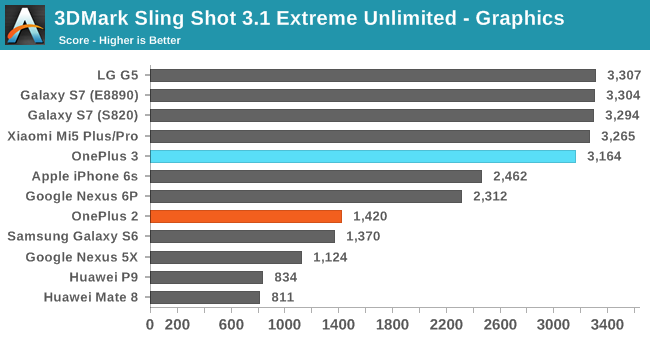
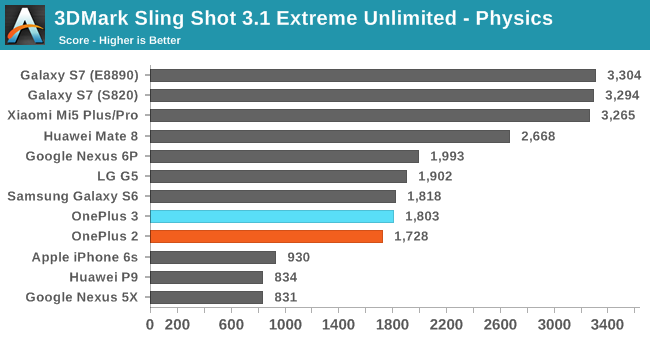
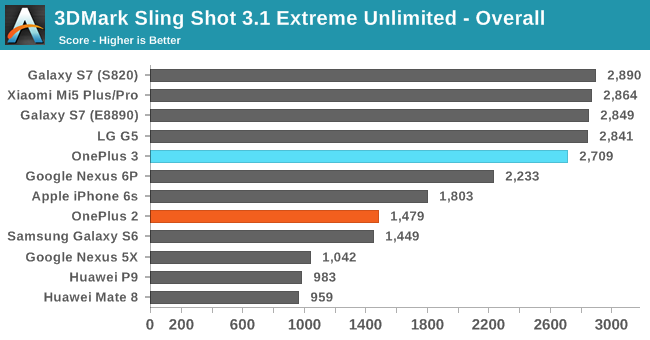
The OnePlus 3 does very well in 3DMark Sling Shot. In both the physics and graphics tests it trails the LG G5 slightly, but the gap isn't anything truly significant. Exynos 8890 is still not something I can compare to until our Galaxy S7 review is posted, but barring that it's clear that Snapdragon 820's Adreno 530 gives the fastest smartphone performance in this test, and when looking at the graphics performance the performance is over two times faster than the OnePlus 2.
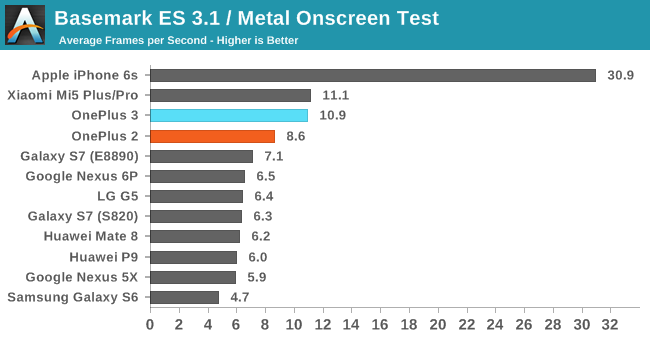
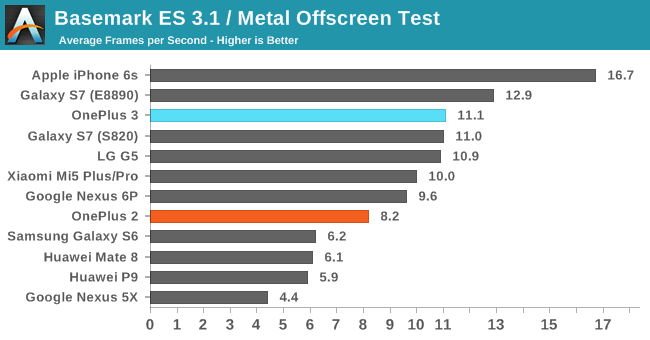
In BaseMark ES 3.1's on screen test the OnePlus 3 manages a significant lead over the LG G5 as a result of its lower resolution. In the off screen 1080p test both phones have essentially the same performance, which is what you'd expect. It looks like Adreno 530 doesn't make the same gains in this test that it does in some others, and it's not clear whether this is just the result of driver optimizations or something about the benchmark that is able to perform batter on other GPU architectures, which could be contributing to the iPhone's lead even in the off screen test.

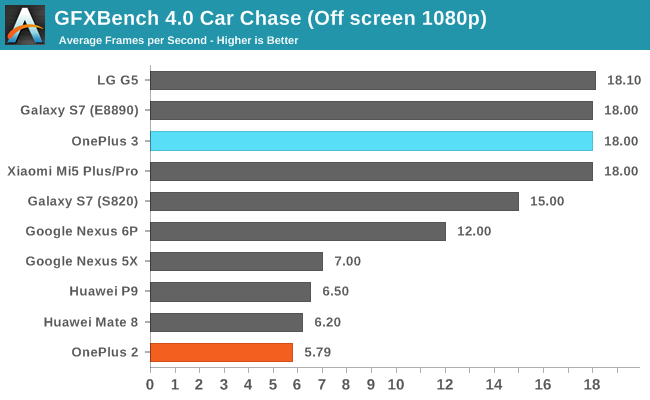
In GFXBench Car Chase the performance of the OnePlus 3 is in line with the LG G5. On screen performance is significantly higher due to the lower resolution display, while off screen performance at 1080p is about the same as the G5 and exactly the same as the on screen result. As far as absolute GPU performance goes, both of our Snapdragon 820 devices are at the top of the chart for absolute performance, and that's good news for anyone playing games or using software that benefits from a powerful mobile GPU.
NAND Performance
The OnePlus 3 moves to a UFS 2.0 NAND solution, which OnePlus claims is three times faster than the eMMC storage used in the OnePlus 2. In more realistic testing you probably won't end up achieving speeds three times faster than the OnePlus 2 since it actually wasn't slow at all by eMMC standards, but there should be a decent uplift in NAND performance nonetheless.
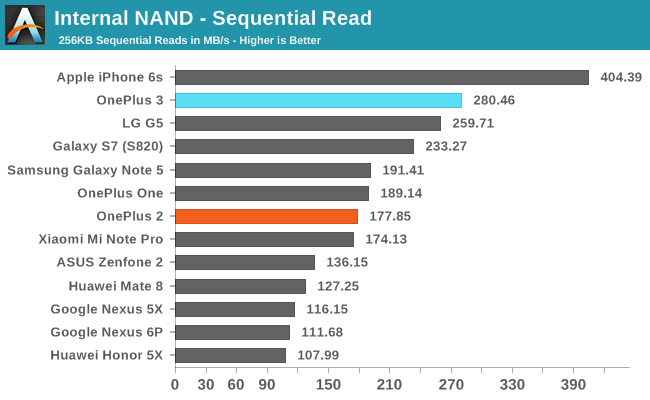
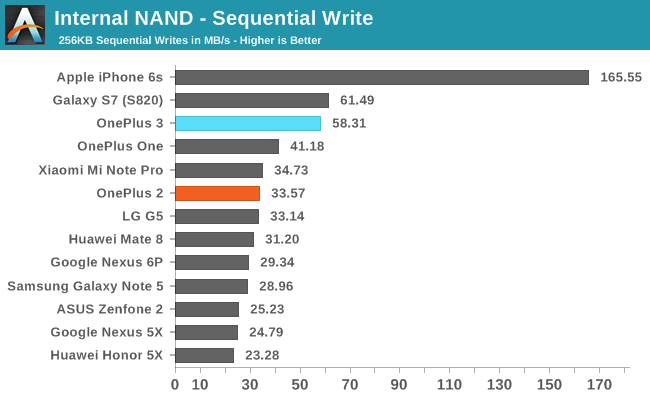
The move to UFS 2.0 brings healthy gains over the OnePlus 2's storage performance, although as I said, the OnePlus 2 didn't perform poorly at all by the standards of eMMC devices. Sequential read and write performance is actually the best that I've measured so far on an Android device. We're still not looking at anything close to what you get for sequential performance on iOS devices, but there are some other factors at play like the fact that the iPhone was a 128GB unit while our Android devices are usually 32GB or 64GB devices. In any case, the OnePlus 3 doesn't present any problems with storage performance, and you certainly won't run into the same issues that you can with budget smartphones at the $200-300 range where the eMMC solutions can be exceptionally slow.










176 Comments
View All Comments
fanofanand - Monday, June 20, 2016 - link
Not to mention I call BS on his entire statement. You really sit around the water cooler with your colleagues discussing the screen quality of your phone? You discuss how great the colors are? Unless you work for a mobile phone manufacturer, you are either lying or the most boring guy in the office.shktr - Monday, June 20, 2016 - link
I work at an IT company. Talking about new tech on a daily basis. So why would it be BS? Who wouldn't discuss their brand new phone and its performance? That aside, I'm curious why most of the people that review the phone are positive about the display? They are all lying? I agree its not the best out there. Yet saying its a poor display is just wrong.UtilityMax - Wednesday, June 22, 2016 - link
I am not a big display quality nut, but the two things I really care about is max brightness and black levels, which basically means that I expect the screen to look good to an untrained eye, either outdoors or in the dark. So it is disappointing to see that Oneplus 3 has max brightness about on the level of Asus Zenfone 2. A lot of people thought this was not even acceptable on a 200-300 dollar device which Zenfone 2 was, but for a 400USD 2016 "flagship killer" it's ridiculous.Eden-K121D - Monday, June 20, 2016 - link
Yep.People should stop whining and accept the fact that oneplus 3 has a POOR displaygrayson_carr - Monday, June 20, 2016 - link
If you call the OnePlus 3 display poor, then I think you have to call the Galaxy S7 display poor as well because by default its display is no more accurate than the OnePlus 3 display. You have to change the display mode from adaptive to basic to make the S7 display accurate, which let's be honest, only about 0.1% of people who buy the S7 do that. I think Anandtech needs to start publishing display measurements using the default display settings as they come out of the box, because that's what 99.9% of people will use and see when they buy the phone. I'm fine with including measurements of the basic mode as well, but I don't think it should be the only measurements shown. The default settings should be measured and discussed considering that's how most people, even enthusiasts who read this site, will use it.Eden-K121D - Tuesday, June 21, 2016 - link
At Least they give an option to change the mode. Oneplus doesn't even do thatLolimaster - Wednesday, June 22, 2016 - link
You have the option and if you care about accuracy you will use it.Avrg people like colors to poop but once you show them how the colors should look (specially when white/black/greyscale are involved) they dont look back after switching to "basic".
Brandon Chester - Monday, June 20, 2016 - link
The screen is not better than the OnePlus One at all. There's no subjectivity here, these are purely objective measurements. If someone enjoys that a display shows completely inaccurate gaudy colors and has a severely blue-shifted white point, there's nobody trying to stop them from enjoying it.An analogy: I enjoy The Room, but I would never try to argue that it's an objectively high quality film on the basis that I enjoy it. You can enjoy a display with poor image rendition, but that doesn't make it good.
grayson_carr - Monday, June 20, 2016 - link
While we're complaining about gaudy colors and shifted white points, I would like to request that Anandtech start publishing display measurements for the default display modes of phones. For example, the Galaxy S and Note lines and the Nexus 6P both ship with displays with gaudy colors and shift white points but default, but we never see those measurements, but just the measurements after you have set them to sRGB mode. The problem with that is that 99.9% of people who buy those phones leave the display settings at the default. I would bet you cold hard cash that even the majority of Anandtech readers leave the display settings at default. And so now we have a bunch of people running around claiming "Anandtech said my phone has like the most accurate display, dude", but then I look at their phone, and uhhh, no. They are using the default display mode and have been mislead into thinking those colors are accurate. I realize that most Anandtech readers aren't dumb enough to pull that, but the problem is, when Anandtech publishes its findings, a bunch of other news outlets come along and say "Anandtech and DisplayMate say this phone displays the most accurate colors ever", but conveniently leave off the part about have to change settings for that to be true. I'm not saying you should test and publish the results in the sRGB modes. You should. I'm just saying you should ALSO publish the results for the default display settings for a device. And if the accuracy sucks at the default settings, you should call it out and complain about it a bit, even if there is an sRGB setting buried in developer options somewhere. You can tell me the Galaxy S7 has a more accurate display than the iPhone 6S all you want, but if I run meet two people when I'm out and one has an S7 and one has a 6S, guess which one is going to be more accurate 99.9% of the time?/rant
grayson_carr - Monday, June 20, 2016 - link
Err, should have proofread before posting. Autocorrect killed me and there's no edit button."I'm not saying you *shouldn't test and publish the results in the sRGB modes."